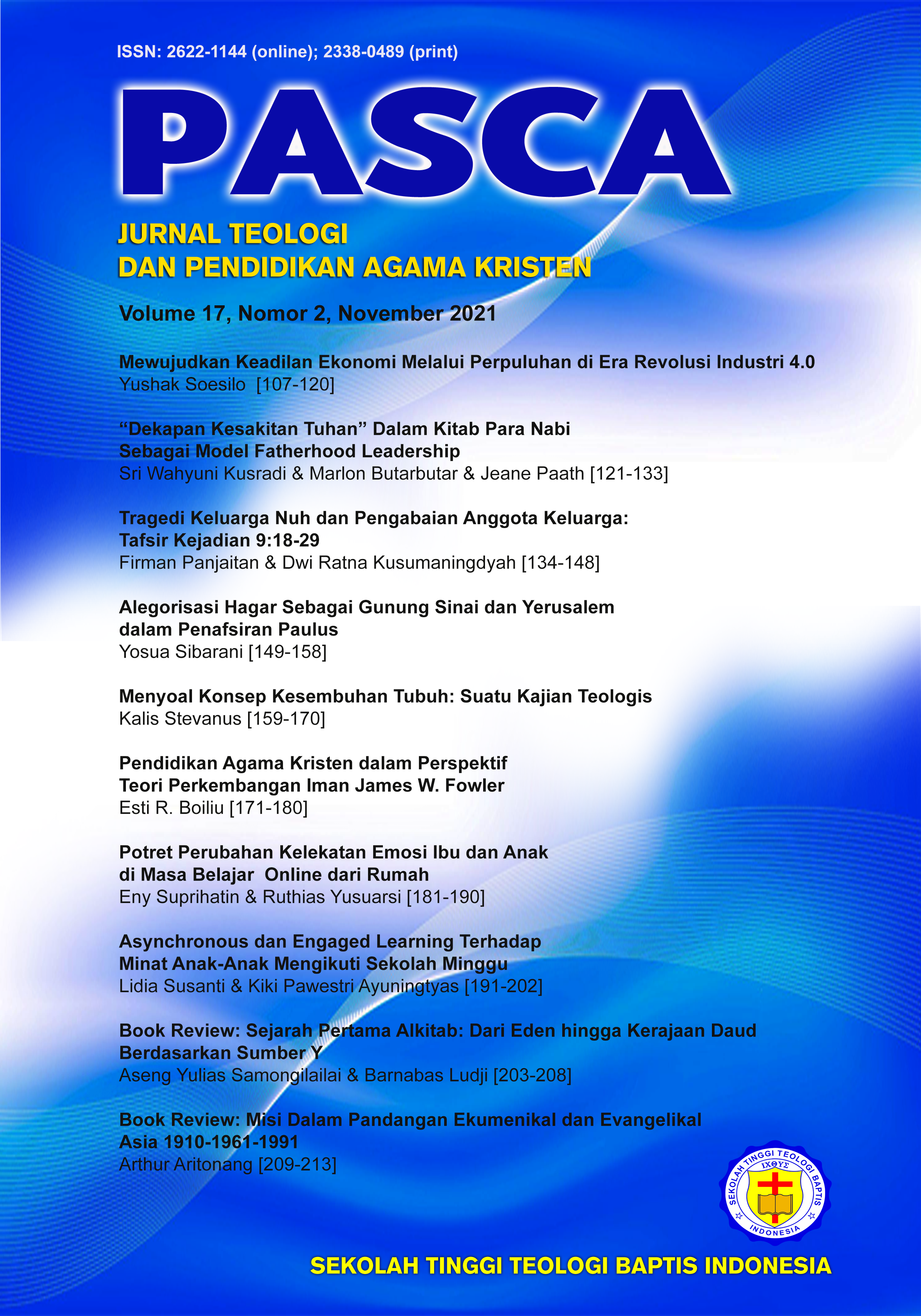Asynchronous dan Engaged Learning Terhadap Minat Anak-Anak Mengikuti Sekolah Minggu
The Use of Asynchronous and Engaged Learning to Generate Children's Interest in Sunday School
DOI:
https://doi.org/10.46494/psc.v17i2.157Keywords:
asynchronous learning, sunday school, Christian education, teacher, pandemicAbstract
During the pandemic, Sunday School activities have challenges: Sunday school teachers are not familiar with technology, children are not used to technology and online meetings. This research was conducted by simple random sampling in several churches in East Java in the Middle class. The total population is 60 children, and the sample taken is 52 children. Data analysis measures the relationship between variables using a correlation test and the magnitude of the influence between variables. This study shows that a teacher can start the Sunday school activities with asynchronous learning during the pandemic using YouTube and WhatsApp media combined with engaged learning strategies that can make children feel involved.
References
Choe, Ronny C., Zorica Scuric, Ethan Eshkol, Sean Cruser, Ava Arndt, Robert Cox, Shannon P. Toma, et al. “Student Satisfaction and Learning Outcomes in Asynchronous Online Lecture Videos.” CBE Life Sciences Education 18, no. 4 (2019). https://doi.org/10.1187/cbe.18-08-0171.
Chung, Ellen, Geetha Subramaniam, and Laura Christ Dass. “Online Learning Readiness among University Students in Malaysia amidst Covid-19.” Asian Journal of University Education 16, no. 2 (2020): 45–58. https://doi.org/10.24191/AJUE.V16I2.10294.
Cohen, Louis, Lawrence Manion, and Keith Morrison. Research Methods in Education. Research Methods in Education. New York: Routledge, 2017. https://doi.org/10.4324/9781315456539.
Douglas, Tracy, Allison James, Louise Earwaker, Carey Mather, and Sandra Murray. “Online Discussion Boards: Improving Practice and Student Engagement by Harnessing Facilitator Perceptions.” Journal of University Teaching and Learning Practice 17, no. 3 (2020). https://doi.org/10.53761/1.17.3.7.
Draus, Peter, Michael Curran, and Melinda Trempus. “The Influence of Instructor-Generated Video Content on Student Satisfaction with and Engagement in Asynchronous Online Classes.” Journal of Online Learning and Teaching 10, no. 2 (2014): 240.
Dziuban, Charles, Patsy Moskal, Jay Brophy, and Peter Shea. “STUDENT SATISFACTION WITH ASYNCHRONOUS LEARNING.” Online Learning 11, no. 1 (2019). https://doi.org/10.24059/olj.v11i1.1739.
Garber, Adam M. “Flipping Out! Utilizing an Online Micro-Lecture for Asynchronous Learning Within the Acting Internship.” Medical Science Educator 30, no. 1 (2020). https://doi.org/10.1007/s40670-019-00887-y.
Geraniou, Eirini, and Cosette Crisan. “University Students’ Engagement with an Asynchronous Online Course on Digital Technologies for Mathematical Learning.” Eleventh Congress of the European Society for Research in Mathematics Education, no. 2002 (2019).
Gómez-Rey, Pilar, Elena Barbera, and Francisco Fernández-Navarro. “Student Voices on the Roles of Instructors in Asynchronous Learning Environments in the 21st Century.” International Review of Research in Open and Distance Learning 18, no. 2 (2017). https://doi.org/10.19173/irrodl.v18i2.2891.
Harmadi, Mariani, and Agung Jatmiko. “Pembelajaran Efektif Pendidikan Agama Kristen Generasi Milenial.” PASCA?: Jurnal Teologi Dan Pendidikan Agama Kristen 16, no. 1 (2020): 62–74. https://doi.org/10.46494/psc.v16i1.72.
Javed, Muhammad, Akhtar Ali, and Azhar Mahmood. “Impact of Globalization on Postgraduate Students’ Asynchronous Learning in English Language.” Pakistan Journal of Distance and Online Learning 4, no. 2 (2018): 67–86.
Karnawati, Karnawati, and Mardiharto Mardiharto. “Sekolah Minggu Masa Pandemi Covid 19: Kendala, Solusi, Proyeksi.” Didache: Journal of Christian Education 1, no. 1 (2020): 13. https://doi.org/10.46445/djce.v1i1.291.
Lew, Edward K., and Erik K. Nordquist. “Asynchronous Learning: Student Utilization out of Sync with Their Preference.” Medical Education Online 21, no. 1 (2016). https://doi.org/10.3402/meo.v21.30587.
Masinambow, Yornan, and Yosef Nasrani. “Pendidikan Kristiani Sebagai Sarana Pembentukan Spiritualitas Generasi Milenial.” PASCA: Jurnal Teologi Dan Pendidikan Agama Kristen 17, no. 1 (2021). https://doi.org/10.46494/psc.v17i1.114.
Mukhtar, Khadijah, Kainat Javed, Mahwish Arooj, and Ahsan Sethi. “Advantages, Limitations and Recommendations for Online Learning during Covid-19 Pandemic Era.” Pakistan Journal of Medical Sciences 36, no. COVID19-S4 (2020). https://doi.org/10.12669/pjms.36.COVID19-S4.2785.
Northey, Gavin, Tania Bucic, Mathew Chylinski, and Rahul Govind. “Increasing Student Engagement Using Asynchronous Learning.” Journal of Marketing Education 37, no. 3 (2015). https://doi.org/10.1177/0273475315589814.
Reeve, Johnmarshall, and Ching Mei Tseng. “Agency as a Fourth Aspect of Students’ Engagement during Learning Activities.” Contemporary Educational Psychology 36, no. 4 (2011). https://doi.org/10.1016/j.cedpsych.2011.05.002.
Saadiah, Halimatus, and Abdul Wahid. “Are Students Engaging in Online Classrooms??” European Journal of Education Studies 7, no. 2019 (2020): 202–22. https://doi.org/10.46827/ejes.v7i12.3408.
Sesmiyanti, Sesmiyanti. “Student’s Cognitive Engagement in Learning Process.” Journal Polingua?: Scientific Journal of Linguistics, Literature and Education 5, no. 2 (2018). https://doi.org/10.30630/polingua.v5i2.34.
Sharma, Deepak H., and Anjali Chachra. “Effective Learners’ Engagement for Learning.” Journal of Engineering Education Transformations 33, no. Special Issue (2020). https://doi.org/10.16920/jeet/2020/v33i0/150084.
Sholehah, Siti Hidayatus, Diana Endah Handayani, and Singgih Adhi Prasetyo. “Minat Belajar Siswa Pada Mata Pelajaran Matematika Kelas IV SD Negeri Karangroto 04 Semarang." Mimbar Ilmu 23, no. 3 (2018). https://doi.org/10.23887/mi.v23i3.16494.
Sistek-Chandler Ed., Cynthia Mary. Exploring Online Learning through Synchronous and Asynchronous Instructional Methods. Advances in Mobile and Distance Learning (AMDL) Book Series. IGI Global, 2020. https://doi.org/http://dx.doi.org/10.4018/978-1-7998-1622-5.
Teng, Michael, and Carmia Margaret. “Sketsa Pelayanan Gereja Sebelum, Selama, Dan Sesudah Masa Pandemi COVID-19.” Veritas: Jurnal Teologi Dan Pelayanan, 2020. https://doi.org/10.36421/veritas.v19i2.432.
Yunitasari, Ria, and Umi Hanifah. “Pengaruh Pembelajaran Daring Terhadap Minat Belajar Siswa Pada Masa COVID 19.” EDUKATIF?: JURNAL ILMU PENDIDIKAN 2, no. 3 (2020). https://doi.org/10.31004/edukatif.v2i3.142.
Yusup Rogo Yuono. “Pertumbuhan Gereja Di Masa Pandemi.” Sagacity 65, no. 2 (2020).
Zaluchu, Sonny. “The Digital Mindset as an Approach to Education Forthe Millenial Generation.” In ICOGESS, edited by Suardin Gaurifa. Medan: EAI, 2020. https://doi.org/10.4108/eai.14-3-2019.2292036.
Zaluchu, Sonny Eli. Sistematika Riset Dan Analisis Data Kuantitatif. Semarang: Golden Gate Publishing, 2018.
Zhang, Xiaoyu, Xiaofeng Chen, Joseph K. Liu, and Yang Xiang. “DeepPAR and DeepDPA: Privacy Preserving and Asynchronous Deep Learning for Industrial IoT.” IEEE Transactions on Industrial Informatics 16, no. 3 (2020). https://doi.org/10.1109/TII.2019.2941244.
Published
How to Cite
Issue
Section
Copyright (c) 2021 Lidia Susanti, Kiki Pawestri Ayuningtyas
PASCA: Jurnal Teologi dan Pendidikan Agama Kristen is licensed under a Creative Commons Attribution-ShareAlike 4.0 International License.



























